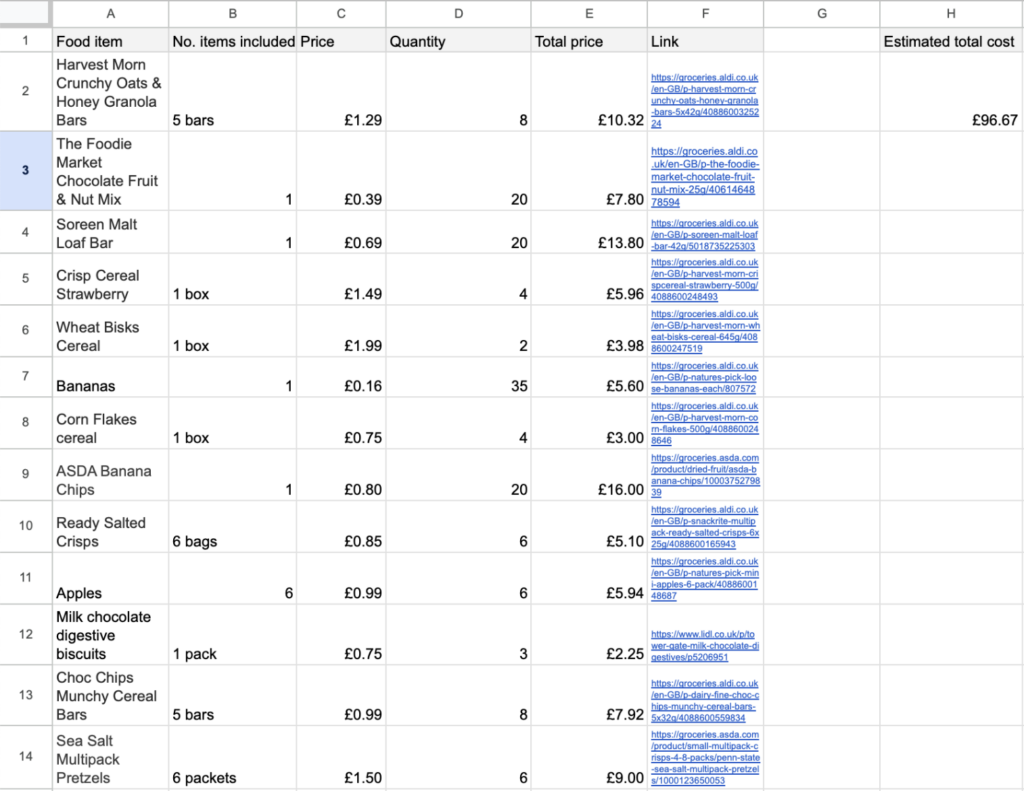The Long Way Home – Third Meeting
This week Martha Rosenweir arranged another production meeting for the 2nd of February, to check up on how we were getting on with our tasks. To prepare for the meeting, I finished off the remaining tasks on my to-do list, which included creating a snack list and cost estimates, and completing a risk assessment for filming in the woods. I started with the snacks list, and created an google sheets spreadsheet that would add up the costs.

I looked for a range of snacks and breakfast foods with nutritional value, to keep crew happy and energised. I did some research by looking at forums such as Quora and Reddit, and articles from organisations such as Raindance. I used advice from these posts to compile a list of foods, which I then found on websites such as Aldi and Lidl. I inputted the foods, their prices, and links into the spreadsheet to provide Martha with all the information necessary to form a final shopping list. I also set up the spreadsheet to automatically adjust the total cost if the quantity of an item was changed, so that Martha could look at my suggestions and change what she wanted whilst still having an accurate representation of how much it would all cost.
To complete the risk assessment I used the template that Martha’s production manager, Liwen Chen, provided. In our last meeting, I had discussed some possible risks with Martha, such as the slight possibility of there being hunting traps left in the forest. I used the list that I had made to start the risk assessment, but to be thorough I also did some research into some general risks associated with filming in the woods. I found a blog that posted a risk assessment they had written for filming in a forest, which I used to add anything I had missed. I compiled the final list of risks onto the risk assessment template. I submitted the document to Martha a couple of days early, so that she could check over my work.
In the meeting on Friday we went over everything, and got final approvals before submission. We also went through all the purchases that needed to be made, like the hand warmers, and made a final decision on which products to go for. We then placed the orders so that they would arrive before shooting.
Masterclass
This week we had a masterclass with editor Lindsay Watson. Lindsay started out as an assistant photographer, but eventually transitioned into being a freelance editor. She spoke about her experience in the industry, and how she taught herself the skills necessary to shift fields. After her talk, I stayed back to ask some extra questions and she recommended some online courses that would help develop my editing skills, such as Lynda and ScreenSkills. My main takeaways from the talk included:
- Know your software
- Good communication with directors and producers is important
- You have to get on with other crew members – you spend a lot of time with them under stress, so work hard and be nice to work with
- Its always better to understand the projects you are working on – research and empathy
- It is ok to use trial and error – sometimes it is best to find story arcs and structure within the rushes
Articles Referenced: https://raindance.org/the-best-foods-to-provide-on-a-shoot/ https://www.quora.com/What-are-some-snacks-that-I-can-feed-my-film-crew-with-Were-filming-from-10-AM-to-2-PM-and-I-have-a-small-budget https://www.reddit.com/r/Filmmakers/comments/23tqkb/filmmakers_what_snacks_are_your_must_have_on_the/ https://www.applespice.com/guide-to-craft-services-film-set/ Woods_Risk Assessment

